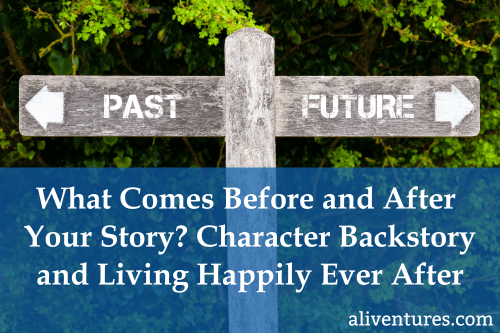What Comes Before and After Your Story? Character Backstory and Living Happily Ever After

The stories that stick with me are ones where the characters feel like real people, with lives before the story begins … and lives that continue after the final page.
These characters don’t feel like mere fictional devices, present merely within the story. They feel like people who have a rich and interesting backstory, and who I can imagine living happy lives – or enjoying new adventures – after the story takes place.
In fact, some readers even feel a sense of characters staying with them in their day-to-day lives, imagining how they might narrate or respond to the world – the Guardian has a fascinating article based on a study about this.
If you want your readers to have a sense of your characters existing outside the bounds of your story, how can you accomplish that?
Assuming that you’ve already done the work of creating interesting, three-dimensional characters, you can flesh their lives out further with backstory and with the sense of the “ever after” beyond the end of your story.
Using Backstory to Give Your Characters a Past
There are all sorts of ways to bring your character’s backstory into the story itself – and I’m not going to dig into detailed techniques here. (If you do want tips, check out my piece on non-linear narratives and K.M. Weiland’s detailed guide to backstory.) Instead, let’s look at why backstory matters to help readers feel that your characters live beyond the story.
As authors, we tend to see backstory as a way to shape the narrative. For instance, backstory is useful to:
- Explain why a character behaves a certain way (especially when they may need to act in an illogical or rash way for the purposes of the plot).
- Add extra tension, perhaps because of an old conflict between two characters that has been simmering away for years before the story gets going.
- Create a sense of mystery through unanswered questions, keeping the reader turning the pages to discover what happened in the past – and how that impinges on the present.
But backstory is also a way to make your characters feel more three-dimensional. Of course, it’s still important that the backstory is somehow relevant to the story you’re telling … but it has more value than simply its immediate relevance.
A rich backstory makes characters feel real to us, instead of them seeming like automatons who appear, speak their lines, then fade into silence again.
Your character’s past, shown through backstory, could cover different generations (in Harry Potter, for instance, a lot of the backstory is about Harry’s parents’ generation) – giving a sense of these characters within families and history. This kind of backstory can round out our sense of the story world, as well as impacting on the present-day of the story.
Living Happily Ever After
I considered putting “happily” in brackets because not all stories end happily! But if you’re writing mainstream or commercial fiction, you’re probably ending on some kind of positive note of resolution or hope.
As readers, we want a sense that the characters carry on beyond the end of the story. You might accomplish that by bringing your main plot to a resolution, but leaving a sense that characters still have new adventures to come. Or you might even leave some things unresolved, but give us the impression (through a positive character arc) that the character is now in a position to face those challenges successfully.
It can be a mistake to tie things up too tightly at the end of your story. (The Epilogue at the end of Harry Potter wasn’t wholly well-received, for instance.) Once your main conflict is resolved, and your main character has finished their character arc, you can leave a lot of the future to the reader’s imagination.
Some good ways to give readers the sense that characters will live on are to:
- Give them hopes, aspirations, or things they’re looking forward to doing in the future.
- Have characters who have started/deepened a relationship – you don’t have to marry them off at the end, but it can be nice to feel that there’s progress in the relationship as well as in their individual arcs. (This could also apply to platonic relationships.)
- Leave a bit of room for the character to grow: even if their character arc is essentially complete, you could have more for them to do and accomplish.
- Show them starting a new adventure. Perhaps a new case comes in for the detective, the sports star is joining an even better team, or the couple are expecting a baby: whatever it might be, we imagine the characters facing excitement and challenges ahead.
You might find it helpful to think about the characters that have stayed with you over the years: the ones that you feel exist outside their stories and who feel very real.
What in the novel or story they’re from makes them feel that way? Is it the backstory, the ending, the complex nature of the characters, or something else … and how might you incorporate a similar technique into your own writing?
About

I’m Ali Luke, and I live in Leeds in the UK with my husband and two children.
Aliventures is where I help you master the art, craft and business of writing.
Start Here
If you're new, welcome! These posts are good ones to start with:
Can You Call Yourself a “Writer” if You’re Not Currently Writing?
The Three Stages of Editing (and Nine Handy Do-it-Yourself Tips)
My Novels

My contemporary fantasy trilogy is available from Amazon. The books follow on from one another, so read Lycopolis first.
You can buy them all from Amazon, or read them FREE in Kindle Unlimited.


0 Comments